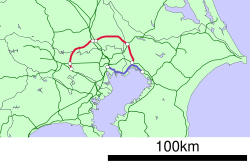Musashino Line
| Musashino Line | |||
|---|---|---|---|

A Musashino Line 205 series on a Keiyo Line through service, January 2010
|
|||
| Overview | |||
| Native name | 武蔵野線 | ||
| Type | Heavy rail | ||
| Locale | Tokyo, Kanagawa, Saitama, Chiba prefectures | ||
| Termini |
Fuchūhommachi Nishi-Funabashi |
||
| Stations | 26 | ||
| Operation | |||
| Opened | 1973 | ||
| Owner | JR East | ||
| Operator(s) | JR East, JR Freight | ||
| Depot(s) | Higashi-Tokorozawa | ||
| Rolling stock | 205 series, 209-500 series EMUs | ||
| Technical | |||
| Line length | 71.8 km (44.6 mi) (passenger operations) 100.6 km (62.5 mi) (Total) |
||
| Track gauge | 1,067 mm (3 ft 6 in) | ||
| Electrification | 1,500 V DC overhead catenary | ||
|
|||
The Musashino Line (武蔵野線 Musashino-sen?) is a railway line operated by the East Japan Railway Company (JR East). It links Tsurumi Station in Yokohama with Nishi-Funabashi Station in Chiba Prefecture, forming a 100.6 km unclosed loop around central Tokyo. Passenger operations are limited to the 71.8 km portion between Fuchūhommachi and Nishi-Funabashi; the Tsurumi to Fuchūhommachi portion, called the "Musashino South Line", is normally used only by freight trains. The line forms part of what JR East refers to as the "Tokyo Mega Loop" (東京メガループ?) around Tokyo, consisting of the Keiyo Line, Musashino Line, Nambu Line, and Yokohama Line.
Most services on the Musashino Line are local trains making all stops. Some trains continue through the Keiyō Line past Nishi-Funabashi to Tokyo, Minami-Funabashi or Kaihimmakuhari.
Other services include:
Tsurumi Station is considered to be the origin of the Musashino Line; trains going clockwise (toward Nishi-Funabashi) are therefore referred to as heading "down" (下り kudari?), while trains going counter-clockwise (toward Fuchūhommachi) are heading "up" (上り nobori?). This is often counterintuitive, as it results in through trains to Tokyo being labeled and numbered as "down" trains while on the Musashino Line; however, such trains switch to "up" after joining the Keiyō Line.
...
Wikipedia

